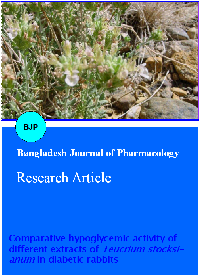Comparative hypoglycemic activity of different extracts of Teucrium stocksianum in diabetic rabbits
DOI:
https://doi.org/10.3329/bjp.v8i2.14519Keywords:
Blood glucose level, ethyl acetate extract, HbA1c, insulin, Teucrium stocksianum BoissAbstract
In the present study crude powder and various extracts of Teucrium stocksianum were evaluated for antidiabetic effect in alloxan-induced diabetic rabbits. Crude extract significantly reduced blood glucose level of normal and diabetic rabbits. The results were comparable with standard drug gliben-clamide. Ethyl acetate extract (500 mg/kg) produced maximum decrease in blood glucose level among all the extracts and was selected for further study. Ethyl acetate extract significantly inhibited rise in glucose level in normal rabbits after an oral glucose load. The extract showed synergistic effect with different doses of insulin. Serum insulin level of diabetic rabbits was also significantly increased by the extract. HbA1c level was significantly (p<0.05) reduced whereas hemoglobin level was significantly increased by the extract. It is concluded that ethyl acetate extract may be a good remedy to manage diabetes and its complications.
Downloads
390
315 Read
46
References
Ahmad M, Alamgeer, Sharif T. A potential adjunct to insulin: Berberis lycium Royle. Diabetologia Croatica. 2009; 38: 13-18.
Akhtar MS, Nadeem M Haroon-ur-Rashid, Bashir S. Hypoglycaemic activity of different fractions of Berberis aristata root-bark in normal and alloxandiabetic rabbits. Can J App Sci. 2011; 1: 16-28.
Akhtar MS, Khan MA, Malik, MT. Hypoglycemic activity of Alpinia galangal rhizome and its extracts in rabbits. Fitoterapia 2002; 73: 623-28.
Ali N, Shah SWA. Antispasmodic activity of Teucrium stocksianum Boiss. Pak J Pharm Sci. 2011; 24: 171-74.
Andrade-Cetto A, Heinrich M. Mexican Plants with Hypoglycaemic effect used in the treatment of diabetes. J Ethnopharmacol. 2005; 99: 325-48.
Babu V, Gangadevi T, Subramonia A. Antidiabetic activity of ethanol extract of Cassia kleinii leaf instreptozotocin-induced diabetic rats and isolation of an active fraction and toxicity evaluation of the extract. Indian J Pharmacol. 2003; 35: 290-96.
Cui G, Jing L, Feng Q, Xiao Y, Putheti R. Anti-hyperglycemic Activity of a polysaccharide fraction from Lycium barbarum. Afr J Biomed Res. 2010; 13: 55-59.
Goth MD. Medical pharmacology. 9th ed. Saint Louis, C. V. Mosby Company, 1985, pp 471-80.
Home P, Mant J, Turner C. Management of type 2 diabetes: Summary of updated NICE guidance. Br Med J. 2008; 336: 1306-08.
Khushk MU, Dahot SA, Baloach, Bhutto MA. The evaluation of soybean extracts in alloxan-induced diabetic rabbits. World Appl Sci J. 2010; 8: 22-25.
Knowler WC, Connor BE, Fowler CE. Diabetes Prevention Program Research Group: Reduction in the incidence of type 2 diabetes with lifestyle intervention or metformin. N Engl J Med. 2002; 346: 393403.
Latha M, Pari L. Effect of an aqueous extract of Scoparia dulcis on blood glucose, plasma insulin and some polyol pathway enzymes in experimental rat diabetes. Braz J Med Biol Res. 2004; 37: 577-86.
McCance DR, Dyer DG, Dunn JA, Bailie KE, Thrope SR, Baynes JW, Lyons TJ. Maillard reaction products and their relation to complications in insulin-dependent diabetes mellitus. J Clin Invest. 1993; 91: 2470-78.
Nishikawa T, Edelstien D, Du XL. Normalizing mitochondrial superoxide production blocks three pathways of hyperglycemic damage. Nature 2000; 404: 78790.
Olajide OA, Awe S, Makinde JM. Purgative effect of the methanol extract of Morinda, Lucida. Fitoterapia 1999; 70: 199-204.
Perfumi M, Arnold N, Tacconi. Hypoglycaemic activity of Salvia fruticosa Mill from Cyprus. J Ethnopharmacol. 1991; 34: 135-40.
Rao BK, Kesavulu MM,Giri R, Appa Rao C. Antidiabetic and hypolipidemic effects of Momordica cymbalaria Hook, fruit powder in alloxan diabetic rats. J Ethnopharmacol. 1999; 67: 10309.
Tomar RS, Sisodia SS. Antidiabetic activity of Annona squamosa L. in experimental induced diabetic rats. Int J Pharm Biol Arch. 2012; 3: 1492-95.
Zaman R, Ahmad M. Evaluation of hepatoprotective effects of Raphanus sativus L. J Biol Sci. 2004; 4: 463-69.
Zimmet P, Alberti KGMM, Shaw J. Global and societal implication of the diabetes epidemic. Nature 2001; 414: 782-87.

Published
How to Cite
Issue
Section
License
Authors who publish with this journal agree to the following terms:
- Authors retain copyright and grant the journal right of first publication with the work simultaneously licensed under a Creative Commons Attribution License that allows others to share the work with an acknowledgement of the work's authorship and initial publication in this journal.
- Authors are able to enter into separate, additional contractual arrangements for the non-exclusive distribution of the journal's published version of the work (e.g., post it to an institutional repository or publish it in a book), with an acknowledgement of its initial publication in this journal.
- Authors are permitted and encouraged to post their work online (e.g., in institutional repositories or on their website) prior to and during the submission process, as it can lead to productive exchanges, as well as earlier and greater citation of published work (See The Effect of Open Access).
